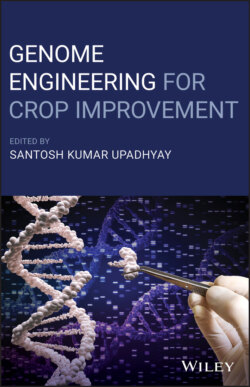Читать книгу Genome Engineering for Crop Improvement - Группа авторов - Страница 48
3.4.1.1 Application of CRISPR/Cas9 for Rice Quality Improvement
ОглавлениеSeveral genes controlling grain appearance attributes have been identified through functional genomics studies. To understand the underlying mechanisms, reverse genetics tools especially the CRISPR genome‐editing system have been utilized. Grain shape, a yield component, plays a key role in determining the quality of rice grains. GS3 a major gene controlling grain length, and Gn1a controlling the number of grains were successfully genome edited in four different cultivars of rice (Shen et al. 2017). The transgene free T1 plants have shown longer grain length and increased thousand grain weight in comparison to wild type. There are multiple genes controlling these attributes further, the interaction and underlying function has also been characterized. The genome interaction of S3 with GW5 also determines the regulation of head rice recovery. The cloning and characterization of OsSPL13 revealed that it has a significant positive impact on cell size in the grain hull, resulting in enhanced rice grain length and yield (Si et al. 2016). Chalk5 is a major QTL and is highly expressed in the endosperm and increases H+ concentration, resulting in water loss from the vacuoles, which ultimately leads to chalky endosperm, an undesirable attribute (Li et al. 2004). OsSPL16/GW8 and GW7 boost grain length and reduce grain width and chalkiness (Wang et al. 2015). Generally, three important physico‐chemical indices, i.e. amylose content (AC), Gel consistency (GC), and gelatinization temperature (GT) determine the cooking and eating quality of rice grain. AC is regulated by the Waxy (Wx) gene in the endosperm (Fiaz et al. 2019), and ALK/SSIIa and RSR1 control GT (Zhang et al. 2011). Several studies have been conducted to unearth the role of different genes and/or enzymes involved in the regulation and expression of the Wx gene. The Indica hybrid rice grown in mainland China has high AC which makes it hard and dry during the cooking process. In another effort, Ma et al. (Ma et al. 2015) knock out the Wx gene in a Japonica rice leads toward reduction in AC. Moreover, transgenic Taichung 65 rice lines with antisense Wx construct showed lower AC, and hybrids developed by utilizing these transgenic lines also demonstrated lower AC (Terada et al. 2000). In comparison, Zhang et al. (Zhang et al. 2018) introduced a loss of function mutation via CRISPR/Cas9 to the Wx gene in two widely grown japonica cultivars “Xiushui134” and “Wuyunjing 7.” The Wx gene mutation caused reduced AC without affecting other desirable agronomic traits. To understand the fine structure and physical properties of starch SBEI and SBEII, they were mutated via targeted mutagenesis. The results showed that SBEIIb plays an important role in producing high amylose rice. The effective editing of several genes proved the reliability of CRISPR/Cas system to understand the functional genomics of genes and transcriptional factors controlling rice grain cooking and eating quality. The improvement in nutritional quality is worthy of consideration, especially those countries where rice is the staple food. It has been estimated, every day approximately 24,000 people die because of poverty based lack of food with adequate content of vitamins, minerals and essential amino‐acids. (Nordin and Lantbruksakademien 2008). The food intake by much of the human population lacks in protein, iron, zinc, vitamin A and iodine (Wenefrida et al. 2009).The application of CRISPR/Cas system can help to improve the nutritional quality of rice grain. The nutritional quality is influenced by the amount of seed storage proteins (SSPs), amino acids contents, fats, vitamins and other essential micronutrients (Peng et al. 2014), but rice has the lowest protein content among the cereal grains (Shewry and Halford 2002). Some amino acids, i.e. lysine (Lys) and tryptophan (Trp) have been reported to be missing from rice grain (Liu et al. 2016). Therefore, improving nutrition in humans is intrinsically associated with improving nutrition in SSPs, especially for people of the regions where rice is being consumed as staple food. Rice contains six 5‐methylcytosine (5mC) DNA methylase genes including OsROS1, OsROS1b, OsROS1c, OsROS1d, OsDML3a, and OsDML3b which can play an important role in enhancing nutritional grain quality. The number of aleurone cell layers was increased by ta2–1 which is a weak mutant allele of OsROS1 (Liu et al. 2018). SSPs include four different categories in rice, albumin, globulin, prolamin, and glutelin, separated by their solubility (Chen et al. 2018). However, the synthesis and accumulation of these four fractions and starch are accelerated by qPC1 which encodes a putative amino acid transporter OsAAP6. Thus, qPC1 significantly increases grain protein content (Peng et al. 2014). Golden rice rich in β‐carotene was developed, by introgressing of four genes including phytoene synthase, phytoenedesaturase, β‐carotene desaturase, and lycopene β‐cyclase to overcome the night blindness caused by vitamin A deficiency in many developing countries (Ye et al. 2000). In conclusion, the genes discussed above have been manipulated through different plant breeding efforts, however, these techniques are time consuming and less efficient. So, to overcome these barriers, using the CRISPR/Cas9 system, i.e. knock‐out/in and multiplex editing, could be an efficient approach to enhance rice grain nutritional value.
